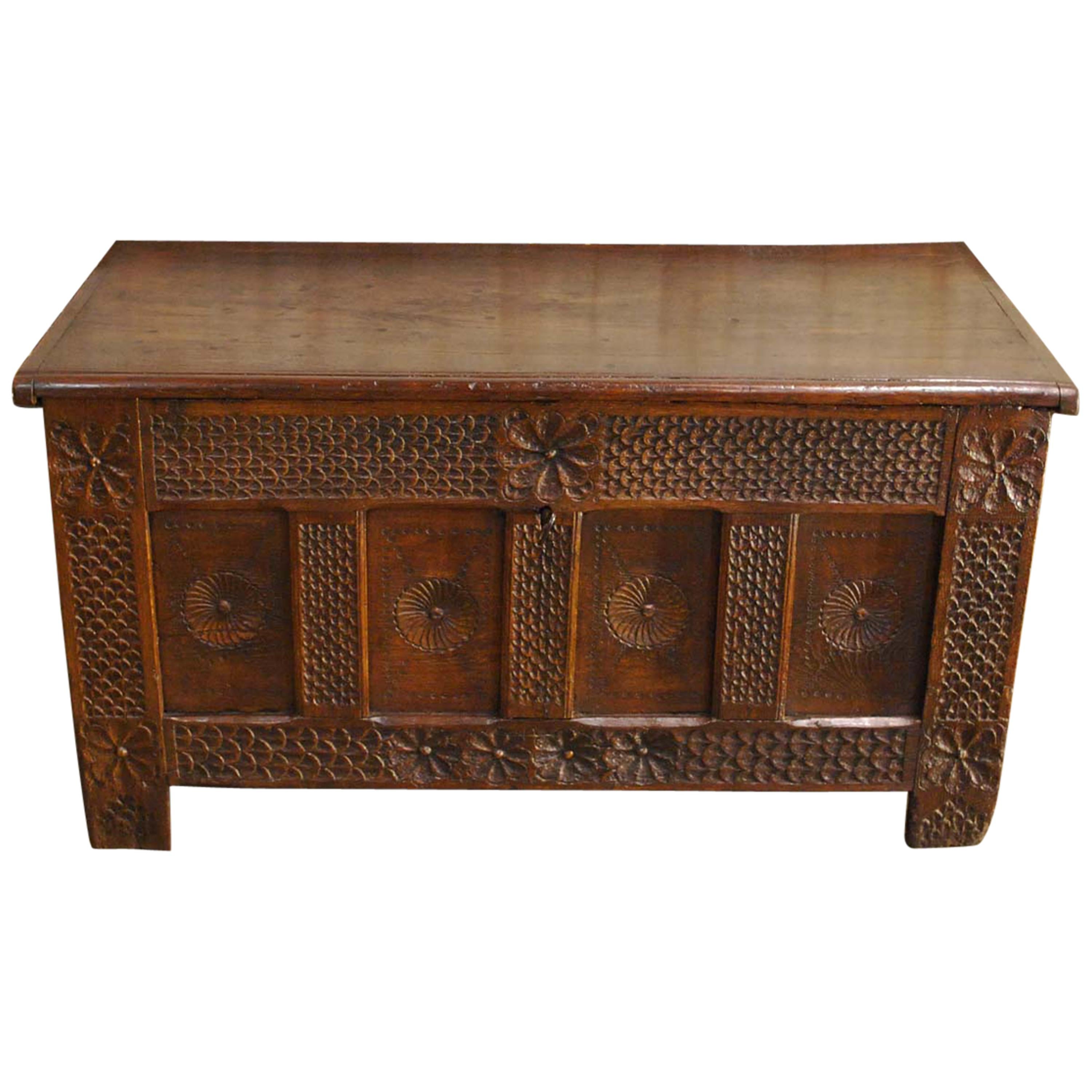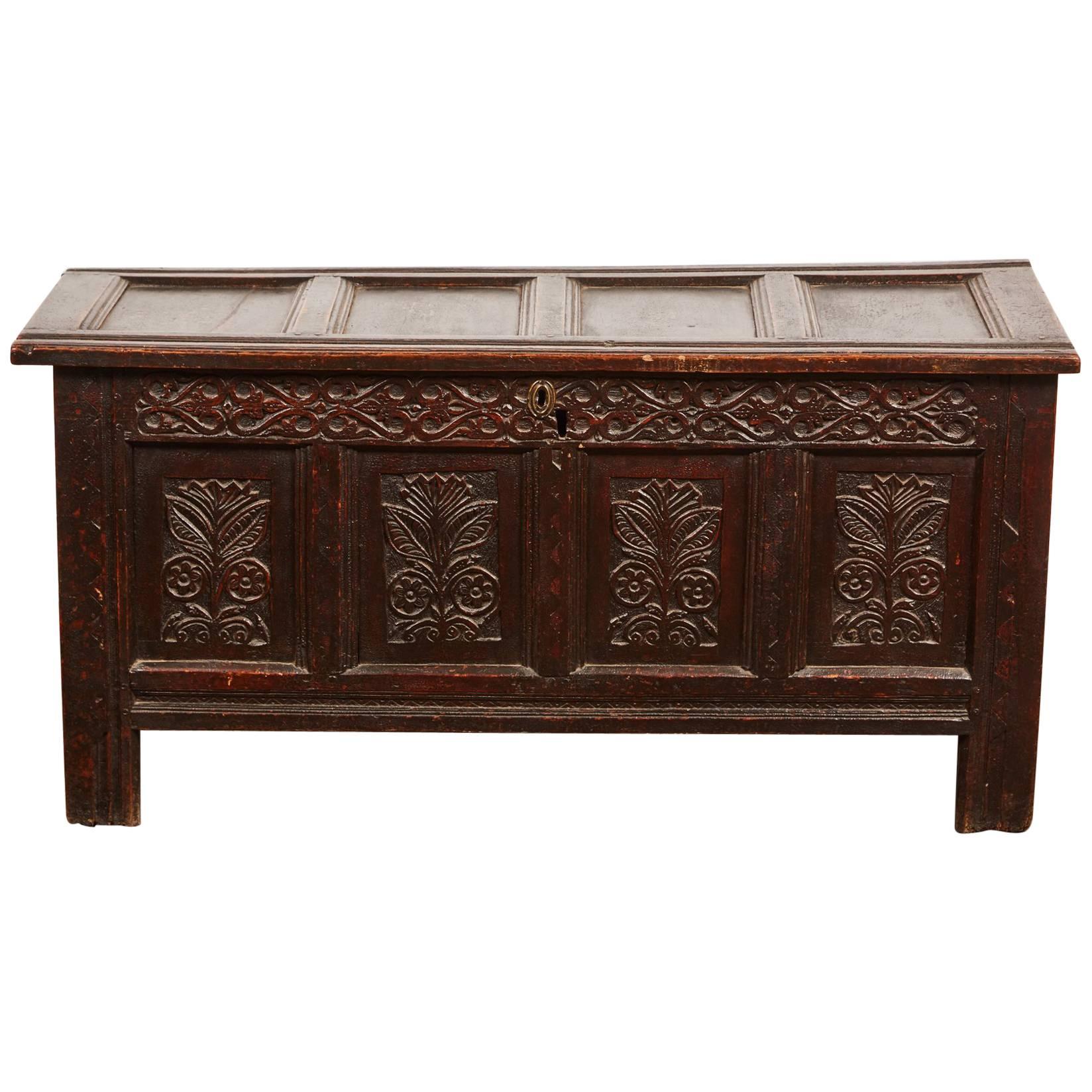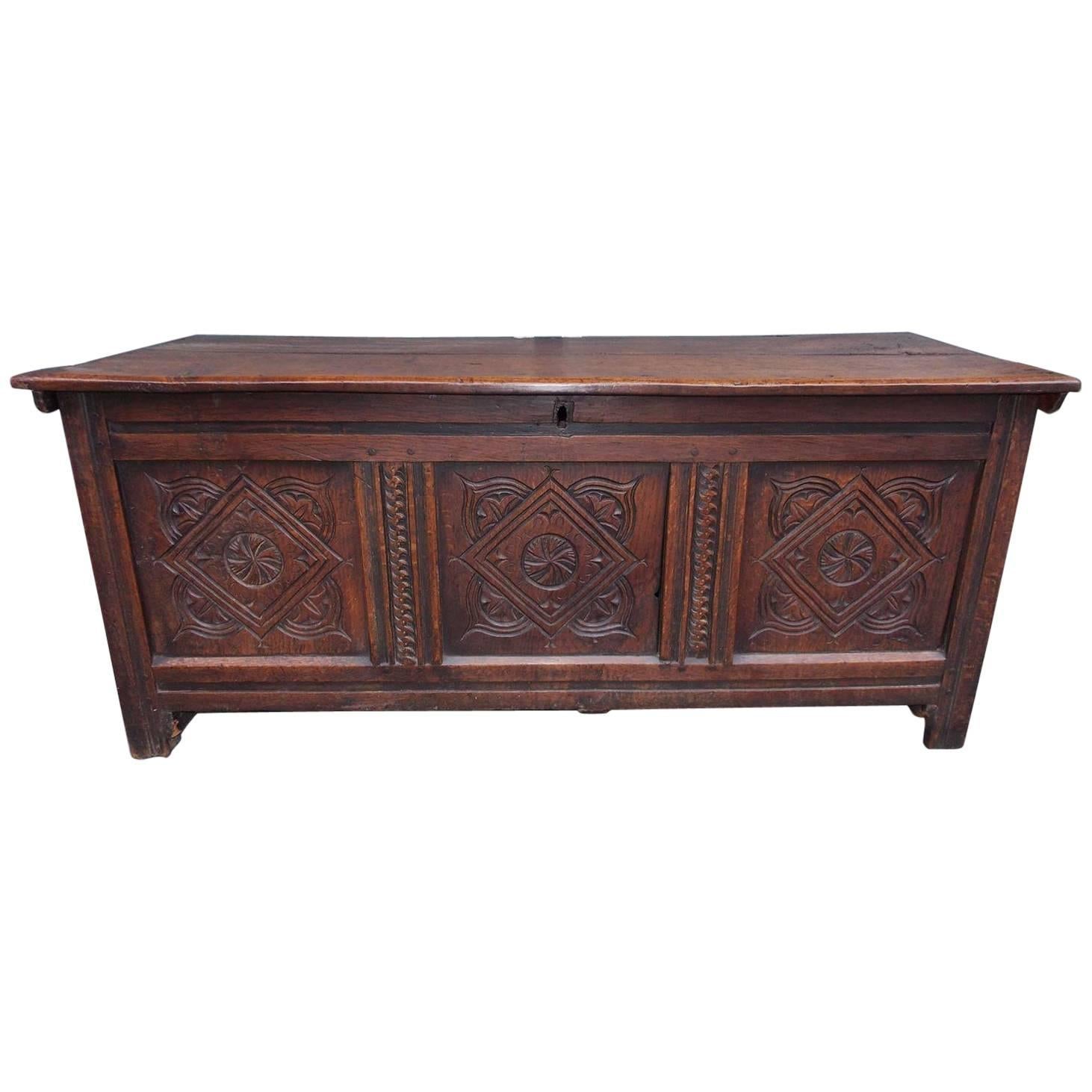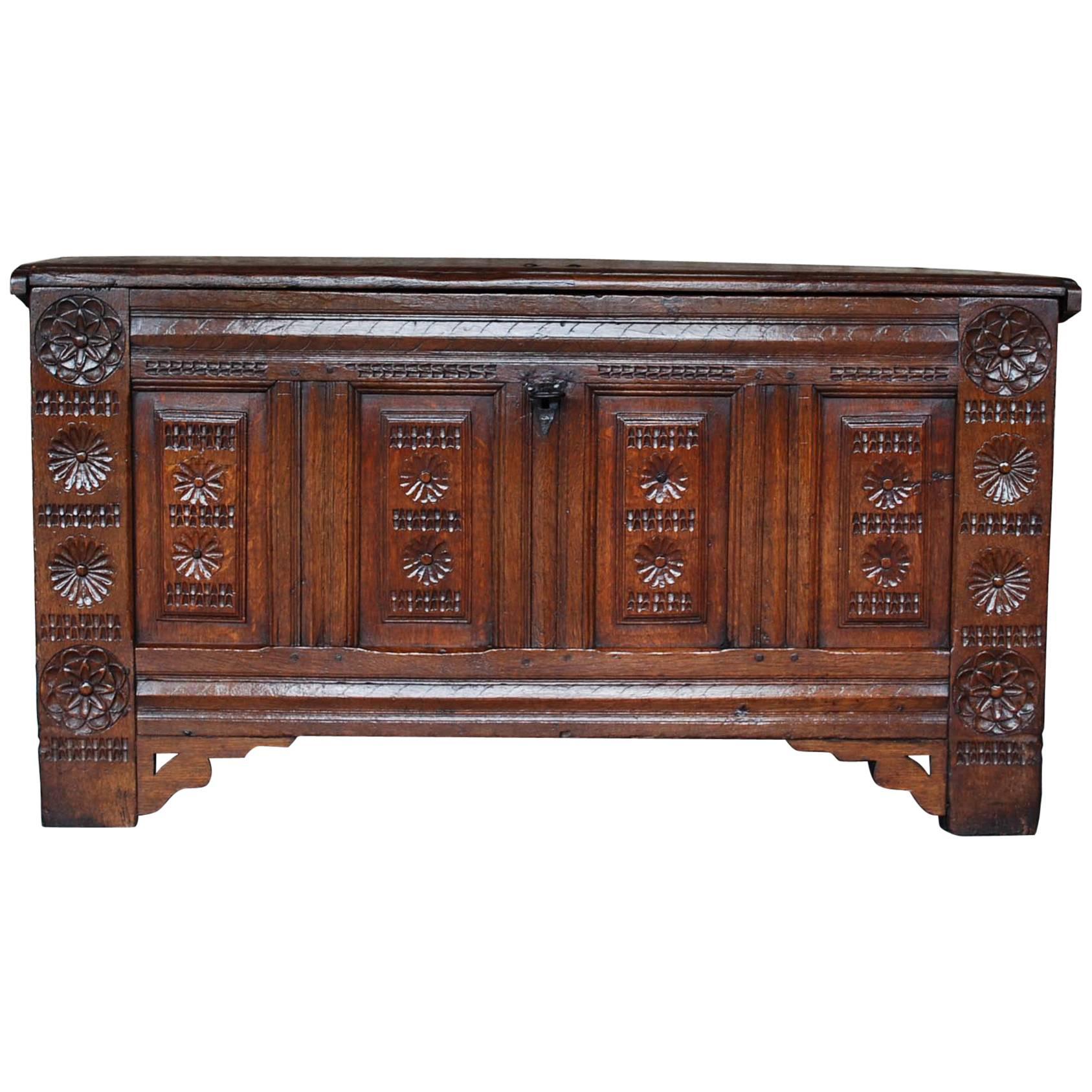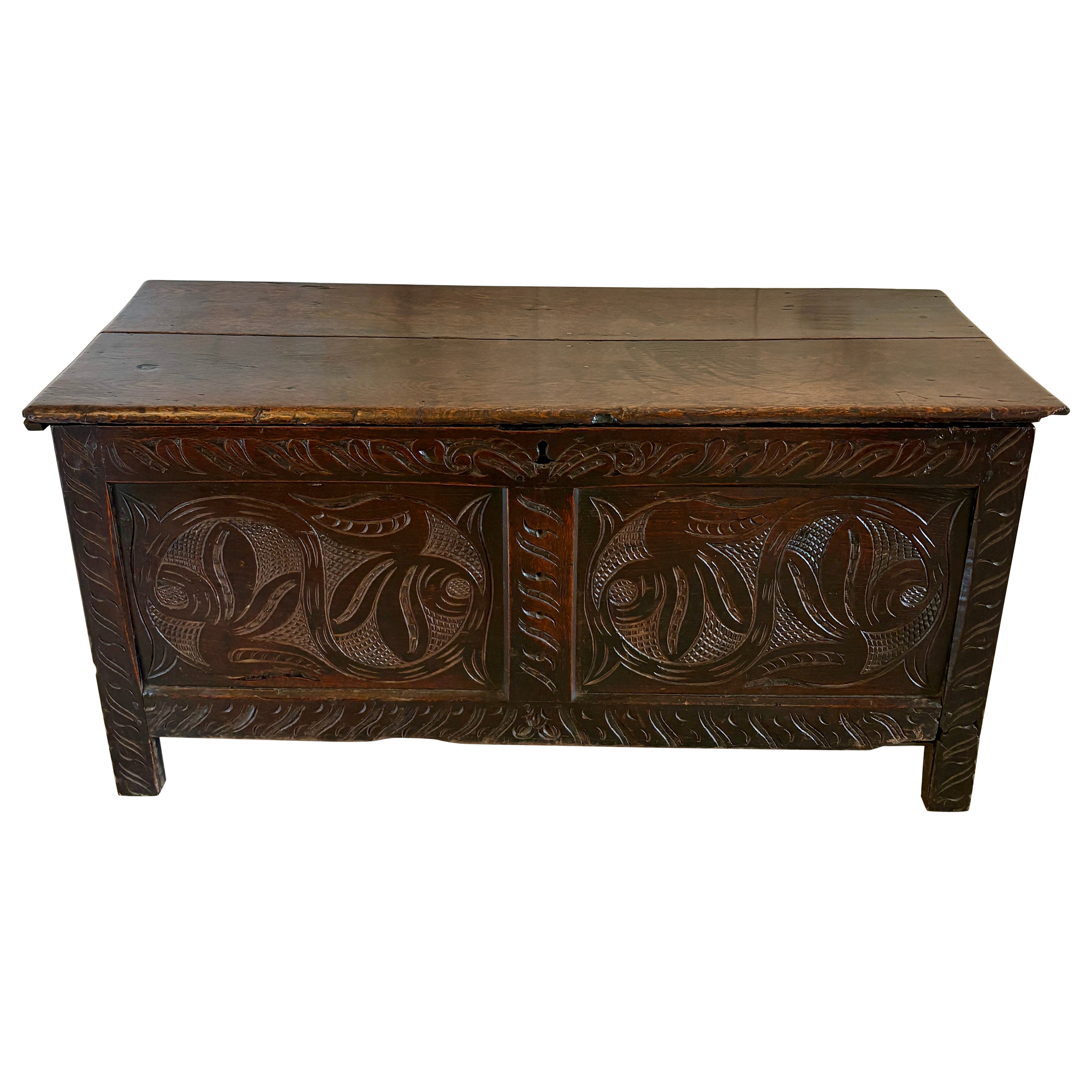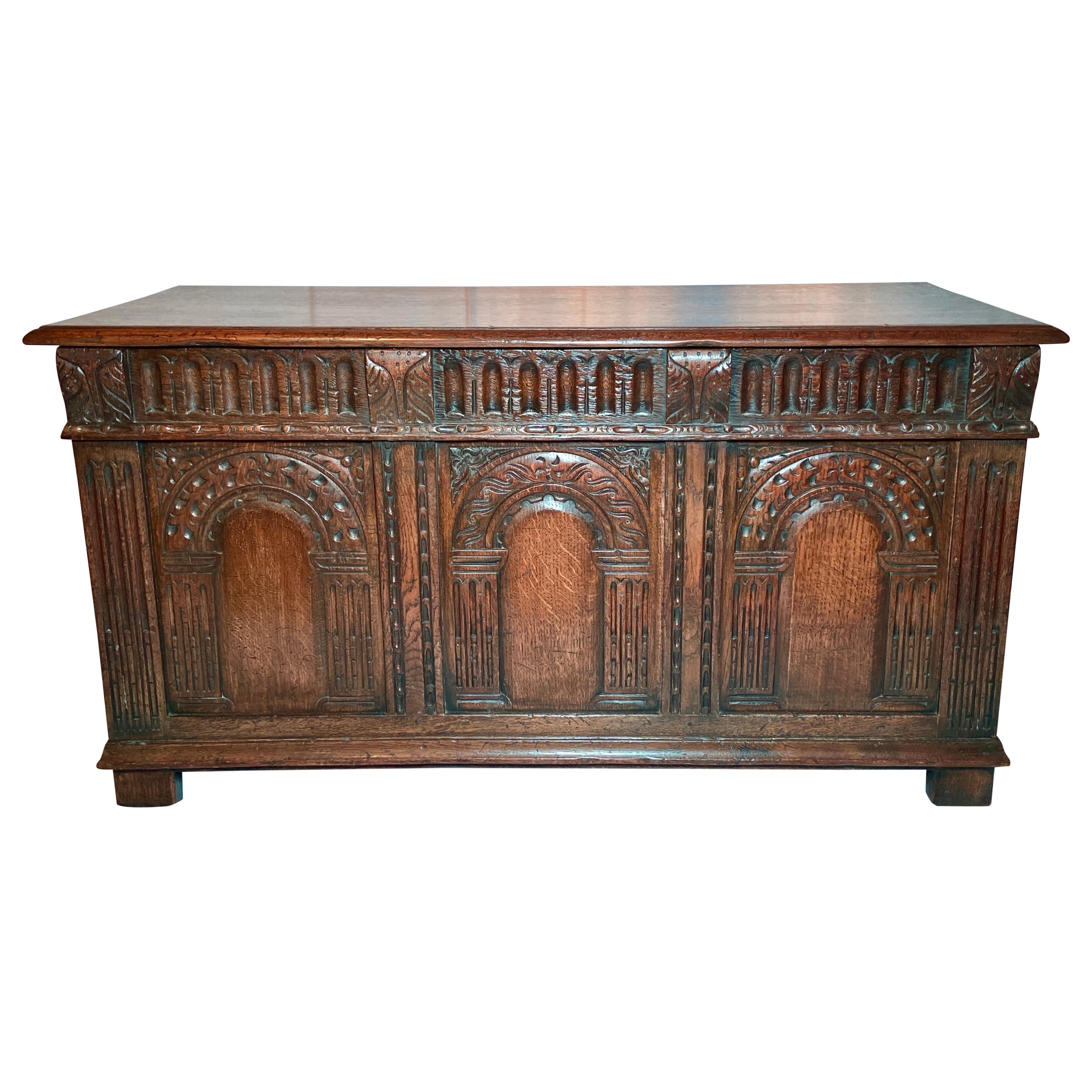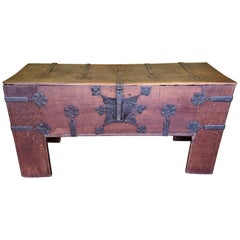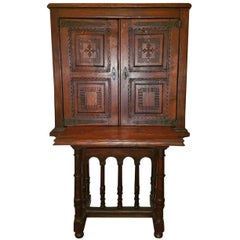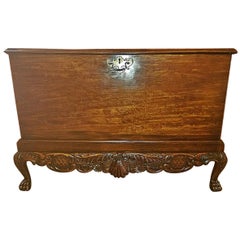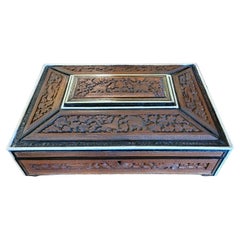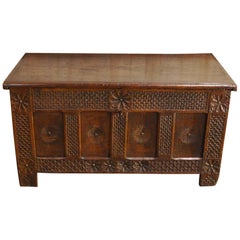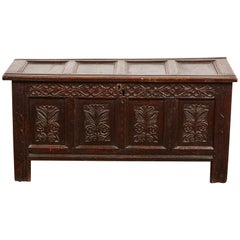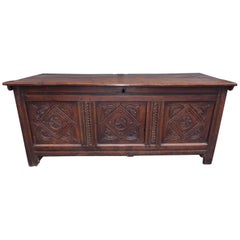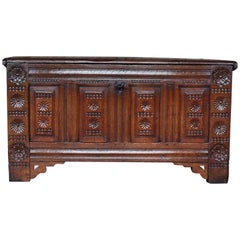Items Similar to 17th Century English Carved Oak Dowry Chest
Want more images or videos?
Request additional images or videos from the seller
1 of 21
17th Century English Carved Oak Dowry Chest
$3,475
$6,95050% Off
£2,673.20
£5,346.4050% Off
€3,102.83
€6,205.6550% Off
CA$4,900.58
CA$9,801.1650% Off
A$5,489.47
A$10,978.9550% Off
CHF 2,883.27
CHF 5,766.5450% Off
MX$66,750.23
MX$133,500.4750% Off
NOK 36,511.61
NOK 73,023.2250% Off
SEK 34,659.34
SEK 69,318.6750% Off
DKK 23,157.60
DKK 46,315.1950% Off
About the Item
Presenting an absolutely gorgeous and historic 17th century English carved oak dowry chest.
Made of solid oak in England, circa 1600-1650.
This piece has all the classic signs of genuine age and 17th century English craftsmanship.
The carvings to the front of the chest are simply stunning. Most definitely in the manner and style of Jacobean carving of that period.
The gothic style pillars in particular were classic elements of Jacobean carving.
The front contains 2 large carved panels with profusely carved scrolling floral bouquets. On each pillar there is carved gothic shaped arch which id replicated in the central pillar. The top panels has a series of 5 florettes across the top with another below the escutcheon. The base panel has a series of carved geometric shaped links. On either side of the chest are the 2 original iron handles with scroll ends.
The piece has had some restoration work done to it, over it’s 400 year history, as one would expect.
The lid or top is an early 20th century replacement, but the restorer has used beautiful solid oak planks, with a patina that beautifully matches the base.
The feet have had 'historic' restorative work performed, as there is clear evidence of petrification of the original feet which would have occurred naturally over the Centuries from standing on stone floors and often in standing water from mopping.
This also assists with age verification of the piece.
The hinges for the top are 20th century replacements as is the front escutcheon, but again the restorer has used iron hinges and an escutcheon to attempt to stay as close to the original as possible.
It is missing it’s original lock. The interior of the chest is as it was made, simple and with real evidence of natural aging.
To large to be a blanket chest, this was most likely a dowry or silver chest.
Gorgeous natural golden oak patina!
The Jacobean era was the period in English and Scottish history that coincides with the reign of James VI of Scotland who also inherited the crown of England in 1603 as James I. The Jacobean era succeeds the Elizabethan era and precedes the Caroline era. The term “Jacobean” is often used for the distinctive styles of Jacobean architecture, visual arts, decorative arts, and literature which characterized that period.
The practical if not formal unification of England and Scotland under one ruler was an important shift of order for both nations, and would shape their existence to the present day. Another development of crucial significance was the foundation of the first British colonies on the North American continent, at Jamestown, Virginia in 1607, in Newfoundland in 1610, and at Plymouth Colony in Massachusetts in 1620, which laid the foundation for future British settlement and the eventual formation of both Canada and the United States of America. In 1609 the Parliament of Scotland began the Plantation of Ulster.
A notable event of James’ reign occurred on 5 November 1605. On that date, a group of English Catholics (including Guy Fawkes) attempted to assassinate the King and destroy Parliament in the Palace of Westminster. However, the Gunpowder Plot was exposed and prevented, and the convicted plotters were hanged, drawn, and quartered.
The fine arts were dominated by foreign talent in the Jacobean era, as was true of the Tudor and Stuart periods in general. Daniel Mytens was the most prominent portrait painter during the reign of James, as Anthony van Dyck would be under the coming reign of his son. Yet the slow development of a native school of painting, which had made progress in the previous reign, continued under James, producing figures like Robert Peake the Elder (died 1619), William Larkin (fl. 1609–19), and Sir Nathaniel Bacon (1585–1627). Some would also claim, as part of this trend, Cornelius Johnson, or Cornelis Janssens van Ceulen (1593–1661), born and trained in London and active through the first two Stuart reigns.
The decorative arts – furniture, for example – became increasingly rich in color, detail, and design. Materials from other parts of the world, like mother-of-pearl, were now available by worldwide trade and were used as decoration. Even familiar materials, such as wood and silver, were worked more deeply in intricate and intensely three-dimensional designs.
Architecture in the Jacobean era was a continuation of the Elizabethan style with increasing emphasis on classical elements like columns. European influences include France, Flanders, and Italy. Inigo Jones may be the most famous English architect of this period, with lasting contributions to classical public building style; some of his works include the Banqueting House in the Palace of Whitehall. St Paul’s Cathedral designed by Sir Christopher Wren in London. See also: Jacobean architecture.
In the domain of customs, manners, and everyday life, the Jacobean era saw a distinctly religious tone. Virginia tobacco became popular. James I published his A Counterblaste to Tobacco in 1604, but the book had no discernible effect; by 1612, London had 7,000 tobacconists and smoking houses. The Virginia colony survived because the English acquired the nicotine habit.
- Dimensions:Height: 32.25 in (81.92 cm)Width: 57.25 in (145.42 cm)Depth: 23.5 in (59.69 cm)
- Style:Jacobean (Of the Period)
- Materials and Techniques:
- Place of Origin:
- Period:Early 17th Century
- Date of Manufacture:1600-1650
- Condition:Repaired: Se full listing for details of restoration and repairs. Wear consistent with age and use. Minor losses. Minor structural damages. Minor fading. Despite repairs this piece is in very good condition for it's age.
- Seller Location:Dallas, TX
- Reference Number:1stDibs: LU3978120896932
About the Seller
4.9
Vetted Professional Seller
Every seller passes strict standards for authenticity and reliability
Established in 2015
1stDibs seller since 2018
390 sales on 1stDibs
Typical response time: <1 hour
- ShippingRetrieving quote...Shipping from: Dallas, TX
- Return Policy
Authenticity Guarantee
In the unlikely event there’s an issue with an item’s authenticity, contact us within 1 year for a full refund. DetailsMoney-Back Guarantee
If your item is not as described, is damaged in transit, or does not arrive, contact us within 7 days for a full refund. Details24-Hour Cancellation
You have a 24-hour grace period in which to reconsider your purchase, with no questions asked.Vetted Professional Sellers
Our world-class sellers must adhere to strict standards for service and quality, maintaining the integrity of our listings.Price-Match Guarantee
If you find that a seller listed the same item for a lower price elsewhere, we’ll match it.Trusted Global Delivery
Our best-in-class carrier network provides specialized shipping options worldwide, including custom delivery.More From This Seller
View AllRare (Late Medieval) 16th Century German Wrought Iron Oak Chest or Stollentruhe
Located in Dallas, TX
WE HAVE THE PLEASURE TO PRESENT an Exceptionally Rare (Late Medieval) 16th Century German Wrought Iron Oak Chest or Stollentruhe.
This is an Early...
Category
Antique 16th Century German Gothic Blanket Chests
Materials
Wrought Iron
Carved Spanish Oak Writing Cabinet, Estate of Vincente Blasco Ibanez
Located in Dallas, TX
Presenting an absolutely stunning 16th century carved Spanish oak writing desk and cabinet, with amazing provenance and historical and literary significance.
This desk/cabinet was purchased by a wealthy Dallas family from a French antique auction held at the club room in the Stoneleigh court (hotel), Dallas on Wednesday the 2nd April 1930. (Now the meridian hotel). The auction was titled: “works of art and furnishings of the Chateau de Turique (Nancy) and the Conde-Rougemont home (Touraine). The cover of the catalog also has a seal of a coat of arms. The second page gives a brief description of the auction contents and states that " this exhibition will be presented by M. Fernand M. Adda of Paris France". The desk/cabinet was lot no: 565 and was described in the auction catalog as:
"Carved Spanish writing desk and cabinet...... 16th century period....Upper section a cabinet with two doors which are paneled and display a fine carving. The interior is fitted with eight engraved drawers, and a writing tablet is disclosed in the lower portion. Sustained and central arcade of columns. From Fontana Rosa collection. Supported on four turned legs with bulbous feet."
Fontana Rosa is a historic garden situated on the avenue Blasco Ibáñez in Menton, Alpes-Maritimes, on the French Riviera. The Spanish writer Vicente Blasco Ibanez (1869-1928) began to build it from 1922 on, and he set up home here with his second wife, Elena, and died there in 1928. Vicente Blasco Ibanez was a journalist, politician and best-selling Spanish novelist in various genres whose most widespread and lasting fame in the English-speaking world is from Hollywood films adapted from his works. The provenance is impeccable, it belonged to Ibanez and was part of his collection at Fontana Rosa when he died in 1928.
The auction in which it was first sold in Dallas was in 1930, which makes perfect sense from a 'timeline' point of view. Ibanez is a very important literary figure. Having regard to the fact that this is a writing desk means that in all probability, Ibanez would have 'penned' some of his famous works at this very desk and using the surviving slope/shelf.
Fontana Rosa is a historic garden situated on the Avenue Blasco Ibáñez in Menton, Alpes-Maritimes, on the French Riviera.
The Spanish writer Vicente Blasco Ibáñez (1869-1928) began to build it from 1922 on, and he set up home here with his second wife, Elena, and died there in 1928.
This garden with Spanish and Menton pottery is found in avenue Blasco Ibanez, near Garavan station, and was created a Historical Monument in 1990.
It is also called “Le Jardin des Romanciers” (El Jardín de los Novelistas/The Garden of Novelists), and was frequented by celebrities such as Jean Cocteau. It was the place where Blasco Ibáñez wrote Mare Nostrum, a novel filmed later in 1926.
The garden inspired by Andalusian and Arabian-Persian styles contains species such as Ficus macrophylla, Araucaria heterophylla , palm trees, banana trees or scented rosebushes. It is a tribute to Vicente’s favourite writers : Cervantes, Dickens, Shakespeare or Honoré de Balzac, whose busts can be found at the entrance and to whom he dedicated several fountains and rotundas.
Its main buildings are a small elevated villa with polychromatic pottery which houses a library and a personal movie projector...
Category
Antique 16th Century Spanish Renaissance Cabinets
Materials
Oak
$10,000 Sale Price
20% Off
18C Irish George II Mahogany Silver Chest on Exceptional Carved Stand
Located in Dallas, TX
PRESENTING AN ‘ABOLUTELY STUNNING’ PIECE OF IRISH FURNITURE HISTORY, namely, an 18C Irish George II Mahogany Silver Chest on the most amazing and EXCEPTIONAL Carved Stand.
Made circa 1745, by an obviously ‘top quality’ Irish Georgian furniture...
Category
Antique Mid-18th Century Irish George II Blanket Chests
Materials
Mahogany
$32,000 Sale Price
28% Off
19c Anglo Indian Highly Carved Teak and Sandalwood Sarcophagus Sewing Box
Located in Dallas, TX
PRESENTING A VERY NICE 19C Anglo Indian Highly Carved Teak and Sandalwood Sarcophagus Sewing Box.
Made in Bombay, India circa 1890-1900.
The box case/body is made of sandalwood wit...
Category
Antique Late 19th Century Indian Anglo-Indian Decorative Boxes
Materials
Bone, Sandalwood, Teak
18th Century Irish Georgian Cork Sideboard
Located in Dallas, TX
Presenting a gorgeous and very rare 18th century Irish Georgian Cork Sideboard of lovely neat proportions.
Made in Ireland during the George III Era, circa 1790 and most likely made in the Southern City of Cork.
A STUNNING Irish provincial piece from the Georgian Era!
Made of solid mahogany, probably imported from Cuba and the secondary woods are oak (as one would expect). Beautiful dovetailing on the inside of the drawers.
The ‘hints’ that this is in fact an ‘Irish’ piece are numerous. The ‘scallop shell’ on the center of the back gallery is unmistakably an Irish Georgian signature. The scalloped fans beneath either side of the central drawer are likewise an Irish signal. The shape, design and style is entirely consistent with similar pieces made in Cork at the end of the 18th Century.
It has it’s original brasses which is fantastic. Lions Head Ring drawer pulls and stunning urn keyhole covers/escutheons.
It has a solid gallery back splat (with central Scallop) and on both sides this ends in curved and carved scroll ends. Beneath the back splat their is a grooved plank section for holding plates etc upright.
The server/counter top area is edged and banded with a carved rope style edging.
The mid section consists of 3 drawers and 2 doors.
The piece sits on 6 legs 4 to the front and 2 to the rear. The front legs are pillars starting at the top with an acanthus style scroll … extending down to another scroll carving directly above the reeded and fluted legs. The 2 rear legs do not have the same fluting detail.
The 2 side doors open to reveal a simple one shelf storage area. One probably held a lead lined cellarette at one time.
The piece is in excellent condition for it’s age and use. There are some minor aging cracks on the counter top on the left hand side. A small loss of molding to the right lower door. No original keys but we are getting replacements made.
Bought in Surrey, England in 1999 by a Private Texas Collector and shipped to Texas. We have the original ‘sales invoice’ and the dealer sold it as a “Regency Mahogany Sideboard circa 1820’and told her that it was an English piece, for the sum of 3,400 GBP. Not only did the dealer not recognize the obvious ‘Irish’ signs...
Category
Antique Late 18th Century Irish George III Buffets
Materials
Mahogany, Oak
19C English Chinese Chippendale Mahogany Buffet or Sideboard
Located in Dallas, TX
PRESENTING A STUNNING AND VERY HIGH QUALITY 19C English Chinese Chippendale Mahogany Buffet or Sideboard.
Probably English, unmarked, but ...
Category
Antique 19th Century English Chinese Chippendale Sideboards
Materials
Mahogany
You May Also Like
Antique 17th Century Carved Oak Dutch Renaissance Maids Chest
Located in Casteren, NL
This solid oak carved chest was made in the Netherlands during the Renaissance period.
It was made in the finest quality oak and high quality carving. The carvings are deep and met...
Category
Antique Mid-17th Century Dutch Renaissance Blanket Chests
Materials
Iron
Late 18th Century English Carved Oak Trunk
Located in San Marino, CA
This late 18th century English carved oak trunk features intricate carvings on the facade. There are four panels with identical abstract flowers on each, as well as a row of continuo...
Category
Antique Late 18th Century English Baroque Blanket Chests
Materials
Oak
English Oak Jacobean Decorative Carved Three-Panel Hinged Coffer, Circa 1720
Located in Charleston, SC
English oak Jacobean hinged coffer with carved molded edge top, three decoratively carved panels consisting of pinwheels, diamonds, and foliage motif while resting on the original ca...
Category
Antique 1720s English Jacobean Blanket Chests
Materials
Wrought Iron
Early 18th Century Carved Oak Dutch Maids Chest
Located in Casteren, NL
This solid oak carved chest was made in circa 1720 and originated in the Netherlands.
It is made in Rebaissance style and it has the typical elevated panels in the front section.
T...
Category
Antique Early 18th Century Dutch Renaissance Blanket Chests
Materials
Oak
$3,262 Sale Price
20% Off
Antique 17th Century Quality Carved Oak Coffer
Located in Suffolk, GB
Antique 17th century quality carved oak coffer having a quality oak lift up top opening to reveal a large storage compartment, carved frieze, two marvellous carved panels to the fron...
Category
Antique 17th Century English Blanket Chests
Materials
Oak
Antique 19th Century English Jacobean Carved Oak Chest
Located in New Orleans, LA
Antique 19th century English Jacobean carved oak chest.
Category
Antique 19th Century English Jacobean Blanket Chests
Materials
Oak
More Ways To Browse
Antique Carved Chest
Carved Wood Chest
Carved Wood Storage Chest
Antique Chest Panel
Hand Carved Antique Chest
Locking Chest
Chest Lock
Antique Chest Lock
Antique European Chest
17th Century English Furniture
American Chest On Chest
Antique Silver Chest
French Oak Chest
Italian Carved Chest
Antique English Chest On Chest
Oak Carved Column
17th Century Carved Cabinet
Two Over Three Chest
